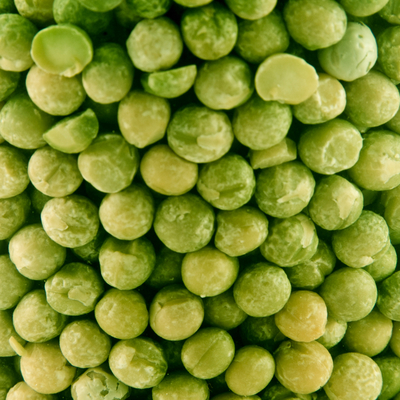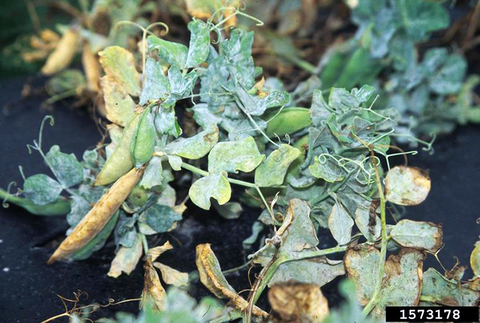Quick facts
- Good growing temperatures are between 55°F and 65°F.
- Peas need less fertilizer than other crops.
- Plant seeds as soon as the ground has thawed and the soil is workable.
- As soon as you pick the peas, cool them quickly. They will keep in the refrigerator for a week or more.
Shelling, snow and sugar snap peas
Peas (Pisum sativum) are a traditional home garden crop all over the world. The most common type in American gardens is the shelling pea, also called the "garden pea" or "English pea." Edible pea pods include snow peas and sugar snap peas.
Some varieties with very small peas are available. Small peas are not necessarily sweeter, more tender or better flavored than larger peas.
Snow pea pods are thin and tender, eaten when there are only tiny traces of peas inside. Sugar snap peas are ready to eat when the peas inside are nearly mature and the pods are still tender and juicy, similar to snap beans.
Pea vines are also edible. You can steam or sautée the tender shoot tips.
Dried peas are also common in soups, after fully maturing and drying.
Soil testing and fertilizer
- Have your soil tested.
- If your soil tests high in phosphorus, use low phosphorus (such as 32-3-10, 27-3- 3, or 25-3-12) or no phosphorus (such as 30-0-10 or 24-0-15) fertilizer.
- Many soils, from sandy to heavy clay, are good for peas as long as you have well-drained soil.
- Peas grow best in soil with a pH between 6 and 7.5.
- Use well-rotted manure or compost at planting.
- Continuous use of high phosphorus fertilizer, such as 10-10-10 or 15-30-15, or high rates of manure or manure compost results in phosphorus buildup in the soil.
- Although phosphate fertilizer applied to soil is bound tightly and resistant to movement in the soil, some runoff may occur. It can then become a major pollution concern in our lakes, rivers and streams.
- Do not use any fertilizer containing a weed killer ("Weed and Feed"), as it may kill your vegetable plants.
Choosing pea varieties
- Nearly all pea varieties on the market are open-pollinated, rather than hybrids. You can save mature pea seed for planting the following season.
- Tall vine varieties can grow up to five feet tall. The vines need a trellis to support them as they climb. These varieties grow peas over a longer period.
- Shorter or "bush" types are only two to three feet tall and will flower and then set their crops all at once.
- Leafless and semi-leafless vines may be less prone to disease. They also may be better able to stand without a trellis, because the tendrils tangle themselves up into a mass.
- Other qualities include number of peas per pod, length of pod, days to maturity, and stringed or stringless pods for edible-pod types.
Garden centers and seed catalogs carry a wide selection of pea varieties. Some varieties are resistant to common pea diseases, including root rots and powdery mildew. Some seeds have a fungicide treatment to improve germination in cold soils.
Starting seeds
Pea growing season is short wherever a cool spring turns quickly to a hot summer, as it does in much of Minnesota. Areas near Lake Superior and in the far northern part of the state may stay cooler into the summer and have a longer time to grow peas.
Most varieties of peas need about 60 days of growth before harvest. But they will stop growing and not produce flowers or pods once temperatures get above 85°F, as often happens in June.
Although the plants do need full sun, peas produced in hot weather may also have poor quality. It is important to get an early start on planting. Preparing the planting area the previous fall may be a good idea.
- Plant the seed as soon as the soil has thawed and is workable.
- Plant tall, vining varieties at the base of the trellis in a single row. Trellises can have two vertical stakes with either string or netting between them.
- You can plant shorter bush types in a single row near a trellis or in a row, between 12 and 18 inches wide, where the plants will cling to and support each other.
- Treat the pea seed carefully. Cracked seeds are unlikely to germinate, especially in cool, moist soil in early spring.
- Place the seeds in a shallow trench, six to seven inches apart. For a wide row, broadcast the seed over the prepared seedbed, with seeds about two inches apart in all directions.
- Evenly place the seeds into a narrow trench in the soil. Make sure they are at a uniform depth and cover them with one inch of soil.
- Firm the soil over the seeds. You may make a second planting a week later, and another a week after that, for a longer harvest period.
Young pea plants can survive light frost and will grow at any temperature above 40°F. Good growing temperatures are between 55°F and 65°F. Once the plants have started to flower and set a crop, frost can be damaging. Watch for any forecast of late spring frost and cover the plants with sheets or row covers if necessary.
Watering
- Because peas grow during a wetter and cooler time of year, you may not need to water them at all.
- During dry springs, you may need to water for good pea growth.
- Try to water the soil, not the vines, to prevent disease.
- Soak the soil when watering, to a depth of at least one inch each week during the growing season.
- Sandy soils may need watering more often.
- Mulching three to four inches deep with grass clippings, weed-free straw, or other organic material will help keep soil moisture and prevent weeds.
Controlling weeds
- Before planting, cultivate with a hoe or other tool, and hand-pull large weeds.
- If peas can get a head start, they can outcompete weeds. But if the weeds get a head start, the pea plants will not grow well.
- Peas have roots that can be close to the surface of the soil. It is important not to cultivate too deeply. Be careful not to damage the plants.
- A wide row of peas, with bushy plants forming a large mass, usually stays weed-free within the row. This setup only needs weed control between rows.
Harvest and storage
Once the pods have begun to fill with peas, observe the plants carefully, sampling the crop each day. Harvest as soon as the peas have reached full size, slightly larger than the dry seed you planted. They will also be sweet, tender, thin-skinned and non-starchy.
Once peas have reached maturity, they will quickly decline in quality. They will be inedible as fresh peas within one to three days.
Over-mature peas have a starchy flavor, less sweetness, tough skins and a firm or hard interior.
Do not pick the peas before they mature. The peas will be too small, with poor flavor and sweetness.
You can freeze peas. Shelling peas and edible pod peas are good candidates.
Shelling peas
After picking the peas, shell immediately and cool. You can also cool them right away for shelling later. The best way to remove heat from a large harvest of peas on a warm day is to dunk them in very cold water until chilled, then dry and refrigerate. Once cooled, they will hold their quality for more than a week in the refrigerator.
Snow peas
To harvest snow peas, wait until the pods have reached their full length as described on the seed packet. The peas within the pod should be visible only as small traces. If allowed to mature further, the pods may become tough.
Some varieties have fibrous strings along the edges of the pods. Remove these strings before cooking. As with shelling peas, it is important to cool snow peas quickly after picking them.
Sugar snap peas
To harvest sugar snap peas, wait until the pods appear almost filled with peas. Sample often as the crop matures. Harvest when peas and pods are still sweet, juicy and tender. Remember that pea quality quickly decreases once they reach maturity. Cool your peas soon after you pick them. Before cooking, you will need to remove the strings of some varieties.
After harvest, typically in June, remove any trellises, and turn the pea plants into the soil. Wait at least two weeks for the soft tissues to break down, then seed or transplant a second crop for fall harvest.
You can also plant a cover crop or put in some annual flowers.
Pea shoots
To harvest pea shoots for stir-fries or steaming, cut six-inch lengths of vine. Edible-pod varieties are good for shoot harvest. Some cooks prefer leafless and semi-leafless types, finding the tendrils tenderer and sweeter than leafy shoots.
Dried peas
Allow the pods to ripen on the plants until they are dry and starting to turn brown, with the seeds rattling inside. This may be as long as a month after you would normally harvest the peas for fresh eating. Pull the plants from the garden once they start to dry and bring them indoors. Hang the plants upside-down in a well-ventilated place to dry completely.
Once the pods and peas are completely dry, strip the pods from the plants and shell out by hand. For a larger crop, place the pods in a burlap sack and thresh by hitting the bag with a stick.
The seeds are likely to have some chaff once separated from the pods and plants. Winnowing is the process of removing little bits of plant material from the seed. Take the seeds outdoors on a dry, windy day and pour them from container to container, allowing the wind to blow through the stream of seeds. The wind will blow away the lightweight plant fiber.
Managing pests, diseases and disorders
Many things can affect pea leaves, flowers and pods. The environment, plant diseases, insects and wildlife can cause changes in physical appearance and plant health. A correct diagnosis is important to solve any plant problems.
You can get help identifying common pest problems by using the Ask a Master Gardener form, where you can share pictures and get input. Or send a sample to the UMN Plant Disease Diagnostic Clinic.
Insects
- Cutworms can cut young pea plants off at the base.
- Aphids can colonize plants in large numbers. You may notice leaf curling, discoloration, and sticky leaves.
- If you have aphids, you may see natural enemies nearby feeding on them.
Diseases
Cultural practices can prevent a wide variety of pea diseases.
- During periods of hot dry weather, powdery mildew can develop on all parts of the plant.
- White mold causes stems to rot and wilt.
Disorders
- Hot day and night temperatures can cause flowers to abort, reducing yield.
- Hot weather can also lead to poor pollination, which leads to fewer pods with smaller peas.
Reviewed in 2024



